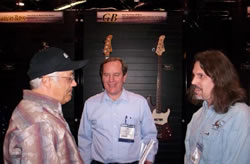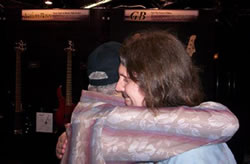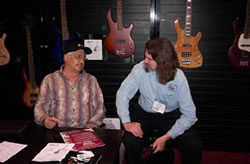In the beginning:
From an early age, Tristram shortened to "TRIS" (grandson of Alice Coffin of New England) showed a great deal of interest in music (always banging on everything in the house with his father's drum sticks). Some of his earliest recollections were of his father recording albums at Kearney Barton's Audio Recording in downtown Seattle. He was thrilled by the complexity of speakers and wires and tape machines and with the inner workings of the recording process.
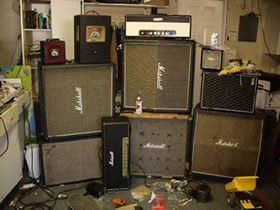
About Mahaffay
Due to his father's success in the local Seattle area, Tris was able to learn the "ins and outs" of the music business from the recording process to live performances. However, it wasn't until age 12, after becoming a Southern California resident, that he got serious about it. Starting on the drums, like his father, he was unsuspectingly forced to take up the guitar after losing a coin toss to his best friend, Steve. Steve wanted to play drums (and already could) ...so he did.
Tris's first band he was associated with was the worlds first “Oasis” -Ron Anderson, Kevin Jones, Steve Greco, Sean Godknecht . They played everywhere in the young OC. All of these boys had a great influence on his musical history. “Particularly Ron Anderson, the very first time I heard Van Halen , I thought to myself, this guy sounds like Ron. He's ripping off Ron!....Ron could sit down with a bunch of mediocre equipment and make it sound like god! -great ear!
We where only 12 years old!” – Tris He adds…
“Kevin Jones is still in my opinion one of the best hard rock vocalist/guitarist ever. He can be heard on countless recordings and still plays in at least three different bands to this day.
Steve Greco, is still my best friend, his group “Usual Suspects” is main stay in the Orange County show case clubs. He plays drums hard—rock n roll hard!
“Sean Godknecht ventured into sound reinforcement and live recording , he has done his home work in this business, if I ever get a stadium tour he will be the only one I call“ Because of his Tris's interest in sound and electronics, finding daytime work in the exploding Southern California electronics industry was easy. By day, now in his teens, Tris worked as a electronics technician. At night he played in various bands throughout the area - mostly for fun but also with a good sense of how the music business was run. He managed to get local air play on Southern California radio stations, played all the clubs and even sold records through the local record stores. Unpredictably in the 80's, the music business decided to basically eat itself alive with more "show" business then actual "music" business and it was at this time, around the mid to late 80's, when Tris had had enough.
With all the time now available to him, Tris focused on what had become an obsession - tweaking his own amps in a never ending search to get "that sound". Tris spent days, weeks and literally years learning how to make an amp sound like it was going to explode while at the same time perfecting a very stable and extremely reliable circuit. All of Tris's amps and most of his friend's got the reworks for free as long as he could experiment whenever he had an idea.
With the inspiration of the Fender Super Champ, designed by Paul Rivera, Tris decided to try his hand at a product that would satisfy the traveling musician with a small but powerful tube based amp. This would later become the Little Lanilei .
In 1990, Tris founded Songworks (now Mahaffay Amplifiers) Systems and Products - a home based business operated solely to design and test a collection of musical instrument devices that he had in mind to market.
In 1994, Tris joined NAMM and proceeded to walk aisle after aisle of the yearly trade show in Anaheim, CA. With his friend Mike, he set out to find a niche where his knowledge would fit into the market. It was at this time that the first experiments were done on a tiny little tube based amp. From the beginning, it was apparent that there was not an "over the counter" solution for many of the components that were needed. It would take a million phone calls and over two years to finally locate the pieces needed, many completely made by hand - and still are. During this two year search for parts, Tris and Mike had been "throwing out" ideas for the name. Mike, an avid Hawaiian shirt wearer, put together the first image and after shuffling around the alphabet a few times the "Little Lanilei Tube Amp" name was coined.
From the beginning, the thought of a graphic design on the grill front had been planned, but it wasn't until Darcey , a local artist and very close friend, presented the image as it appears today. Armed with her immense creativity in art and knowledge of embroidery and with the help of her perfectionary woodworker husband James, the Little Lanilei tube amp made it's first appearance at the winter NAMM show in 1997 - to rave reviews!
Now, over years in production, the little amp has come a long way. Three new models are available as well as a few other clever devices - such as the "Little Lanilei Rotary Wave Speaker". They are all still hand built one at a time, just like the originals, using the finest components available with point to point construction.
We would like to thank you for stopping by our web page and invite you to take some time to read the reviews and customer comments on our products. We truly believe we have the most unique and exciting musical instrument products around!
Sincerely,
Mahaffay Amplifiers
The Lanilei is hand built in the good ol ' USA !
Support small business in America!
Chuck Mahaffay
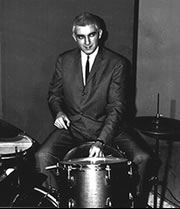
A Seattle jazz pioneer in the truest sense, Chuck Mahaffay helped launched the careers of many northwest musicians. Starting in radio at the University of Washington, he led a more thaA common question is why did he stop at the top of his career nano seconds away from becoming a very well know household name. His story would make a great great movie script. (Anyone out there a screen writer?)
It's a story of hopes and dreams as well as shattering blows. Anyone who has faced trying to make it in the music business knows it's all to common to have the rug pulled out from you at every turn.
That rug had no end, murder ,love, lust ,jealousy, back room business arrangements, fist fights with local restaurateur- Ivar Hagland ?? black balling, music union Mafia ties, you name it... state and local government corruption...oh my god!! My reply to this question is a complicate as the man himself. I truly believe he was stripped of his destiny by major and minor but fatal blows that lead to his quitting at the moment he should have succeeded.
A week after his death in 1993, in a small black box that i found in his tiny one room studio apartment in Seattle (across the street from Cornish) I found a letter from Quincy Jones from the 60's ...it said simply,

to believe the scene here man!!"....
My heart sank. It still kills me to think how he was so low in his predicaments(s) he could not gather the strength to board a plane and leave Seattle. To meet his true destiny like his friends. Why didn't he go? he launch Larry Coryell's career at 19 and his replacement in the Individuals- Ralph Towner or Oregon fame.
He played late nights with Quincy, Ray Charles. He was on his way. What the F$#@ happened?
After years or sole searching of my own, and reading notes of all sorts of things in his rather well organized files, I have not come to any one conclusion..... and that haunts me to this day.
I feel deep down maybe he was hoping some of his ol ' buddies would toss him a rope, or maybe there was more of a darker sinister plot? How does one go from lunch with the mayor and a local entertainer at the top of his game to ZERO? very perplexing. As my mother said " he just dropped out“
I personally get a great kick out of renewed interest in his music, his records show up on ebay and record web sites from all over the world.. it just makes me smile. If he only knew.... what would he say.
If you have not ever heard my pops music, give me a ring or email , I'll send you a free CD. they are time capsules of the 60 jazz scene in Seattle, you can almost feel the "rain" of emotion in the music.
A time when "cool" was late night after hours bars...off the beaten path. The place every one wanted to be...Just Awesome!!
Thanks for listening, Charles " Tris " Mahaffay , son of Chuck the "Gray Ghost".
(they all knew didn't they dad)
I saw this on ebay and thought it was a great review- Tris
Chuck Mahaffay and The Individuals with LARRY CORYELL
"The Girl From Ipanema " Twenty One Records L-2101 (Dad's own label) Stereo Original 1964 Issue Private Release
ebay'r said:
Recorded July 24th, 1964 at Audio Recordings in Seattle, WA.
The first release on this private, Seattle label, the first recorded output from this group and more of interest to most; the first recording for 22 year-old Larry Coryell, who had just joined the group a few months earlier. He is featured on electric guitar and on "alto guitar".
The name of this group -"The Individuals, is quite apt, as they all have very distinct voices and styles. In fact every oneof them has a turn at the vocals; both lead and in their infectious harmonies -the LP is made up of a fairly even number of instrumental and vocal pieces; Larry Coryell sings lead on the Bacharach and David song "Lovers and Wives"; perhaps the most "pop" thing on the LP. His own composition though, is quite a different story; a poignant instrumental of pre-fusion, loping, "cool" bluesy jazz that reminds of noir movie themes and smoke-filled cafes of Paris. Entitled "Late Night", it features sultry lead guitar lines and chordal riffing from Larry and fluid, slippery reedwork as well as great use of vibes.
All the members but Coryell are multi-instrumentalists. Besides his guitar, the most predominately defining instrumental voice is the vibraphone of Bill Franklin, who also plays Alto sax and drums. There's more in the Film-noir vein here and a few pieces, including bassist, Tamara Burdett's instrumental composition Bossa Nada, the vocal title track, Jobim's The Girl From Ipanema and Exodus, that are distinctly Brazilian in flavor.The group formed in 1957, as a completely instrumental jazz quartet, eventually taking on more standards and pop oriented jazz; while stirring things through some genuinely brilliant, though deceptively understated arrangements.
The overall feel is after-hours urban cool. Very tasty obscurity that sneaks up and won't let go.


